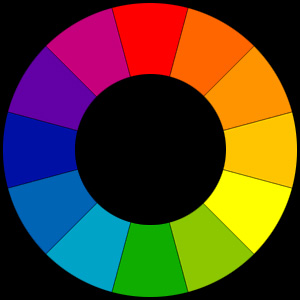Hi Everyone!
As a Makeup Artist, I often get questioned about what colors to use for eyeshadow, lipstick, concealer, etc. In order to get the answer to these, you first need to know a little bit about color. Let’s talk about color theory!
PRIMARY AND SECONDARY COLORS
 Going back to the basics, take a look at the color wheel. Primary colors are blue, yellow, and red. Secondary colors are orange, violet and green. These secondary colors are made by mixing two of the primary colors. Still with me? For instance, mixing red and yellow (both primary colors) make orange (which is a secondary color). Try mixing red and blue (both primary colors) together and what do you get…violet, which is a secondary color. Let’s try another one. Mix yellow and blue, again these are primary colors, and what do you get? Green…which is a secondary color. Simple…right? I think you’ve got this!
Going back to the basics, take a look at the color wheel. Primary colors are blue, yellow, and red. Secondary colors are orange, violet and green. These secondary colors are made by mixing two of the primary colors. Still with me? For instance, mixing red and yellow (both primary colors) make orange (which is a secondary color). Try mixing red and blue (both primary colors) together and what do you get…violet, which is a secondary color. Let’s try another one. Mix yellow and blue, again these are primary colors, and what do you get? Green…which is a secondary color. Simple…right? I think you’ve got this!
Note: “Hue” is pure color, “Tint” is hue + white, and “Shade” is hue + black.
TERTIARY COLORS
Moving on! There are six tertiary colors: red-orange, yellow-orange, yellow-green, blue-green, blue-violet, and red-violet. You can get these colors by mixing a primary color with a secondary color. Oooo pretty! 🙂
COOL AND WARM COLORS
Cool colors are blue based such as greens, blues, and violets. Warm colors are yellow based such as red, orange, and yellow.
ANALOGOUS COLORS
Now that you have primary, secondary, and tertiary colors down, let’s talk about something called analogous colors. These are colors that are adjacent to each other on the color wheel with one being the dominant color (tends to be the primary or secondary color), and the two on either side complimenting, which can be tertiary. (Example: blue violet, violet, and red violet). Analogous colors are very important to know when choosing shades to build a smokey eye and blending out.
COMPLEMENTARY COLORS
Choosing a complementary eyeshadow for your eye color is easy. Find your eye color on the color wheel and follow the line directly across on the other side of the wheel to get the exact opposite color. For instance, if your eyes are green, use a purple or burgundy eyeshadow. If your eyes are blue, use an orange eyeshadow (think peach or bronze). Brown eyes, you can use any shade you would like. If you have more gold, use copper or purple. Brown eyes that are darker with more warmth, try blues and purples to make your eye pop. Hazel eyes have a mixture of colors. Choose which color you want to play up and then find the opposite on the color wheel. Who knew figuring out what eyeshadow to use would be that simple!
UNDERTONE
In order to find that perfect shade of red lipstick, know your undertone. If your skin is a warm (yellow based) undertone, choose an orange-red. If your skin has cool (pink based) undertone, choose a blue-red.
CONCEALER
Concealer can be tricky…but knowing the color wheel will make things so much easier. Here are some tips: Orange cancels blue, green cancels red, yellow cancels violet. If you have a blemish, that is a shade of red. Use a concealer with green in it to cancel out the red. Under eye circles may be a shade of blue, violet, or blue-violet. Choose a concealer with orange in it to cancel out the blue. Concealer with yellow in it will cancel out the violet. Mix orange and yellow concealer to cancel out the blue-violet.
Let’s review! Primary colors: blue, yellow, red; Secondary colors: orange, violet, green; Tertiary colors: red-orange, yellow-orange, yellow-green, blue-green, blue-violet, and red-violet. Analogous colors: adjacent on the color wheel; Complementary colors: opposite on the color wheel. Of course there are exceptions, but theses are general rules to follow.
You have now completed Color Theory 101, so go create some amazing looks!
♥ Debra Johnson Makeup Artist Orange County, California
Don’t forget to share, and comment!

Great info!
Thank you Jenya! 🙂